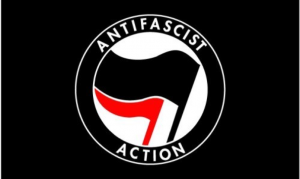
Extremism Assessment Series: Antifascist Action (ANTIFA)

Image: The most identifiable form of the Antifa logo used by the group and found in public sources.
- ANTIFA represents a semi-disorganized collection of extremists on the far-left, sometimes considered the alt-left
- ANTIFA is more accurately described as a brand, as opposed to a formal group, however, for ease of understanding it may be referred to as such throughout this assessment
- With the upcoming presidential election, ANTIFA violence should be expected to rise alongside increasing political turmoil
Summary of Extremist Narrative
ANTIFA’s self-described purpose is to counter fascism and prevent fascism from taking root in society. The ‘enemy’ of ANTIFA does not stop solely with fascists, however. Individuals believed to be far-right, conservative, and even individuals considered center-left on the political spectrum may be identified as an enemy of ANTIFA. Within the often militant organization, tactics for accomplishing objectives can vary from acts of violence, vandalism, criminal damage to property, or spreading of propaganda in interest of their ideology.
Within the social and political roots of ANTIFA, free speech is targeted as believers in the underlying ideology of ANTIFA believe that select speech is violent and must be suppressed for the betterment of overall society. This is a key justification for believers to resort to violence. As such, law enforcement has been deemed as an accessory to the enemy by ANTIFA as law enforcement seeks to separate clashing political protestors, hence preventing ANTIFA from attacking those they deem the enemy.
History of the group
The majority of individuals who identify as ANTIFA come from Marxist political backgrounds, including communists and socialists. It is important to understand that ANTIFA does not represent a single organization or network. Numerous groups or individuals may consider themselves ANTIFA members, leading to the group being highly disorganized in terms of the overall structure.
The history of the ideology that brought about ANTIFA can be found in both the history books as well as in the writings of various political theorists. Communism, socialism, and far-left anarchism have had a small following within the US for well over a century. Such Marxist political leanings often call for a societal revolution to rise up through militant activities to support their political agendas.
Political theorists have argued that the spread of extremist political leanings begets the rise of the opposite form of extremism along the linear political spectrum. Regardless of which form of extremism first came about, ANTIFA believes that ‘fascist creeping’ has begun to attempt to take hold within the United States. This partially is cited as justification for violent acts against those considered supporters of fascism. While various international groups have used a varying version of ‘anti-fascist action’, the current American use began in the mid-2000s.
In the lead up to the 2016 presidential elections, ANTIFA surged in activity and membership with followers engaging in acts of violence across the nation. Protests and counter-protests sparked civil unrest unlike anything observed in decades in the United States with groups like ANTIFA at the forefront of the violence.
Current state of the movement
ANTIFA is very much active as an extremist ideology and brand. With the modern version of the group having become increasingly active and violent since its inception just over a decade ago, ANTIFA will be a source of far-left extremism for the foreseeable future. The ability for ANTIFA to inspire and recruit people into its brand of thinking is highly dependent on a politically volatile United States, which most would agree is the current operating environment. With the looming 2020 presidential election approaching, look for ANTIFA or ANTIFA inspired violence to increase.
Where is ANTIFA operating?
As has been widely observed, ANTIFA is often found participating in political protests across the nation. Primarily located in major US cities or on college campuses nationwide, ANTIFA often has a presence amongst more volatile far-left protests.
What are the primary recruitment methods into the movement?
ANTIFA messaging can be found easily on the internet. The spread of Mark Bray’s 2017 writing, Antifa: The Anti-Fascist Handbook, is a ready source of information for the brand and helps to spread its ideology. The spread of this and related writings on the internet has been fostered by various online communication platforms that also serve as communications centers for the coordination of physical militant activities and the organization of protests and counter-protests.
The Extremism Assessment Series is an initiative of Rise to Peace’s Domestic Counter Terrorism Program. It seeks to provide short educational pieces highlighting groups or social movements linked to extremist ideologies and/or tactics. Check back for new additions to the series.
